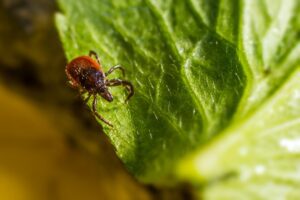Jack Russell Terriers are energetic, intelligent and loyal dogs that make great companions for active people. However, these lively terriers are also prone to flea and tick infestations, which can cause discomfort, irritation and health problems for them and their owners.
This post may contain affiliate links: Read more here.
Fleas and ticks are parasites that feed on your dog’s blood and can transmit diseases such as Lyme disease, tapeworms and anemia. Therefore, it is important to protect your Jack Russell from these pests and treat them promptly if they occur.
In this article, we will show you a step-by-step approach to flea and tick management for Jack Russell Terriers, including prevention, detection and treatment methods.
What are fleas and ticks and why are they a problem for Jack Russell Terriers?
Fleas and ticks are small insects that attach themselves to the skin of animals and humans. They bite their hosts and suck their blood, which can cause itching, irritation, inflammation and infection.
Fleas and ticks can also transmit diseases such as Lyme disease, Rocky Mountain spotted fever, tapeworms, anemia and allergic reactions.
Fleas and ticks are especially a problem for Jack Russell Terriers because they have a thick coat of fur that provides a good hiding place for the parasites.
Moreover, Jack Russell Terriers tend to be very active and adventurous, which means they often come into contact with tall grass, bushes, trees and other places where fleas and ticks can be found.
If left untreated, fleas and ticks can cause serious harm to your Jack Russell Terrier’s health and well-being.
Step-by-Step Approach to Flea and Tick Management for Jack Russell Terriers
Step 1: Identify the Signs and Symptoms of Flea and Tick Infestation.

The first step to flea and tick management is to identify the signs and symptoms of infestation in your Jack Russell. Some of the common signs include:
- Scratching, biting or licking excessively
- Redness, inflammation or scabs on the skin
- Hair loss or bald patches
- Flea dirt (black specks) or flea eggs (white specks) on the fur or bedding
- Ticks attached to the skin or ears
- Fever, lethargy or loss of appetite (in severe cases)
If you notice any of these signs in your Jack Russell, you should inspect them carefully for fleas or ticks. You can use a fine-toothed comb or a magnifying glass to look for them on the fur or skin.
You can also use a white paper towel or cloth to wipe your dog’s coat and check for flea dirt or eggs. If you find any fleas or ticks on your dog, you should remove them as soon as possible.
Step 2: Choose the Right Flea and Tick Prevention Products for Your Dog.

The second step to flea and tick management is to choose the right prevention products for your Jack Russell. There are many products available on the market that claim to protect your dog from fleas and ticks, but not all of them are safe or effective.
Some products may contain chemicals that are harmful to your dog’s health or may not work well for your dog’s breed or size. Therefore, it is always best to consult with your vet before using any flea and tick prevention products on your dog.
Your vet can recommend the best products for your Jack Russell based on their age, weight, medical history and lifestyle.
Some of the common types of flea and tick prevention products include:
- Topical spot-on treatments: These are liquid products that are applied between the shoulders of your dog once a month or every two months depending on the product.
They kill fleas, flea eggs, lice and ticks on contact and prevent re-infestation for a period of time. Some examples of these products are Frontline Plus, Revolution or Advantage. - Oral tablets or chews: These are pills or soft chews that are given to your dog orally once a month or every two months depending on the product. They kill fleas and ticks by interfering with their nervous system or reproductive cycle.
- Collars: These are collars that are worn around your dog’s neck continuously for several months. They release chemicals that repel or kill fleas and ticks on contact or when they bite your dog.
- Shampoos, sprays or powders: These are products that are applied directly to your dog’s coat during bathing or grooming. They kill fleas and ticks on contact but have a short-lasting effect. They may need to be reapplied frequently or combined with other products for better protection.
Step 3: Apply the Products Correctly and Regularly.

The third step to flea and tick management is to apply the products correctly and regularly according to the instructions on the label or from your vet. You should follow these general tips when using flea and tick prevention products on your Jack Russell:
- Read the label carefully and make sure the product is suitable for your dog’s breed, size, age and health condition.
- Follow the dosage and frequency recommendations and do not overdose or underdose your dog.
- Apply the product in a well-ventilated area and avoid contact with your eyes, skin or mouth.
- Keep the product away from children, other pets and food sources
. - Monitor your dog for any adverse reactions such as vomiting, diarrhea, itching, swelling or seizures. If you notice any signs of toxicity, contact your vet immediately.
- Do not use more than one type of product at the same time unless advised by your vet. Some products may interact negatively with each other and cause harm to your dog.
- Do not use expired or damaged products as they may lose their effectiveness or become unsafe.
Step 4: Monitor Your Dog’s Health and Behavior for Any Adverse Reactions.

The fourth step to flea and tick management is to monitor your dog’s health and behavior for any adverse reactions to the products or the parasites. Some dogs may be allergic or sensitive to certain ingredients or chemicals in the products and may develop skin rashes, itching, swelling or other symptoms.
Some dogs may also have an immune-mediated reaction to the parasites themselves and may develop anemia, fever, joint pain or other complications. Therefore, you should watch your dog closely for any changes in their appearance, appetite, energy level or mood.
If you notice any signs of distress, discomfort or illness in your dog, you should take them to the vet as soon as possible for diagnosis and treatment.
Step 5: Keep Your Home and Environment Clean and Free of Fleas and Ticks.

The fifth and final step to flea and tick management is to keep your home and environment clean and free of fleas and ticks. Fleas and ticks can survive and reproduce in your carpets, furniture, bedding, clothing and other places where your dog spends time.
They can also be brought into your home by other animals or people who visit you. Therefore, you should take these measures to prevent or eliminate flea and tick infestations in your home and environment:
- Vacuum your floors, carpets, rugs, upholstery and curtains regularly and dispose of the vacuum bag or filter in a sealed plastic bag.
- Wash your dog’s bedding, toys, collars and leashes in hot water and soap regularly and dry them thoroughly.
- Use flea and tick sprays, powders or foggers to treat your home and yard according to the instructions on the label or from your vet. Be careful not to inhale or ingest the products or expose them to children, pets or plants.
- Trim your grass, weeds and bushes around your home and yard to reduce the hiding places for fleas and ticks.
- Avoid taking your dog to areas where fleas and ticks are prevalent such as woods or fields with livestock. If you do, check your dog for fleas and ticks after returning home and remove them promptly.
Well, That’s a Wrap
Flea and tick management is an essential part of caring for your Jack Russell Terrier. By following these steps, you can protect your dog from these annoying and dangerous parasites and ensure their comfort and well-being.
You can also prevent flea and tick infestations from spreading to your home and environment and affecting you and your family. By doing so, you can enjoy a happy and healthy life with your Jack Russell Terrier.
About the author: Jacob Kay is a Veterinary Advisor at WWD, a passionate dog lover, and a dedicated advocate for animal welfare. With vast expertise in veterinary medicine, he generously shares his insights on dog care, covering essential topics like nutrition, exercise, health, and safety. As a responsible pet owner himself, Jacob’s knowledge and passion extend to two adorable pet dogs. He strongly advocates for spaying and neutering as a vital step in curbing the population of homeless animals and promoting a healthier, happier pet community.

